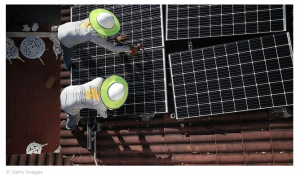By Ruth Santiago and Michael B. Gerrard*
This opinion piece was first published in The Hill. It is available here.
 The Biden administration faces a choice that could advance two of its core objectives — fostering environmental justice and fighting climate change.
The Biden administration faces a choice that could advance two of its core objectives — fostering environmental justice and fighting climate change.
Puerto Rico’s already troubled energy system was devastated by Hurricane Maria in 2017 and a magnitude 6.4 earthquake in 2020. The Federal Emergency Management Agency (FEMA) has allocated $9.6 billion for electric system work in Puerto Rico. FEMA now has to decide whether to use this money on yet more fossil-fuel generation, which would worsen the unhealthy levels of air pollution, or instead devote most of it to rooftop solar, which would be healthier for residents, create more local jobs and make the power supply more resilient to disruption of the fragile electrical grid.
Puerto Rico’s electric system is highly centralized and based on 97 percent fossil-fired generation. The fossil fuel plants emit multiple pollutants that adversely impact the health of nearby communities. The AES coal-fired power plant in Guayama and the Aguirre Power Complex in Salinas, both in southeastern Puerto Rico, are two primary sources of air pollution and toxic emissions in the archipelago and disproportionately impact some of the poorest communities. These two plants also extract large amounts of freshwater from the South Coast Aquifer, the primary water supply for thousands of people, and have contributed to the water scarcity that has led to water rationing. The Costa Sur and EcoElectrica plants in southwestern Puerto Rico both burn imported “natural” methane gas and transmit energy long distances using the vulnerable transmission and distribution system. The San Juan and Palo Seco power plants also adversely impact nearby communities with emissions from combustion of dirty oil and methane gas.
Much of the existing energy infrastructure is in flood-prone areas or at risk of sea-level rise, storm surge and tsunamis.
The Puerto Rico Electric Power Authority (PREPA) has submitted a plan to FEMA for the use of these funds that would perpetuate the use of fossil fuels. This is despite the fact that the 2018 Bipartisan Budget Act allows for the use of funds for alternative technologies, such as on-site solar, plus storage that would keep the lights on at night. The Puerto Rico Energy Public Policy Law makes facilitation of distributed energy resources such as roof-top solar and storage a key part of Puerto Rico energy policy.
Nonetheless, PREPA’s 10-year plan and its funding requests to FEMA call for spending at least $853 million on two new natural gas-fired power plants. This plan also sets aside over $8 billion for transmission system work that would perpetuate the existing long-distance, south to north, transmission of energy, as well as the environmental injustice already experienced by fence line communities located near heavily contaminating power plants in southern Puerto Rico. Rebuilding and hardening the existing transmission and distribution system to maintain reliance on fossil fuels and centralized generation would condemn these communities — comprised of a majority of impoverished Afro-descendants — to continue suffering disproportionate and adverse health effects caused by air, water and land pollution.
PREPA’s plan, currently being evaluated by FEMA, fails to adequately consider the rooftop/on-site solar and storage alternatives that could have positive, enduring multiplier effects in environmental justice communities, the local economy and employment rates. Moreover, wide scale rooftop/on-site solar and storage would not rely on the system of overhead wires whose collapse in Hurricane Maria led to blackouts that were linked to hundreds of deaths because life-saving medical equipment was shut off.
Puerto Rico is a very sunny place. Civil society groups, including community, environmental, labor, professional organizations and academia, co-founded and endorse the Queremos Sol, or “We Want Sun,” proposal, which promotes the transformation of PREPA to achieve wide scale implementation by the power utility of on-site/roof-top solar and storage, energy efficiency, demand response and energy literacy programs.
The FEMA funds present a once-in-a-generation opportunity to transform the energy system. Earmarking federal funds for localized solar and storage through the public utility, which can develop a transparent procedure for large scale deployment of rooftop solar and storage, serves four purposes:
Tiffany is the Communications Associate at the Sabin Center for Climate Change Law.




